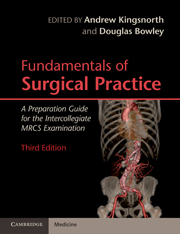Book contents
- Frontmatter
- Contents
- List of contributors
- Preface
- Section 1 Basic Sciences Relevant to Surgical Practice
- Section 2 Basic Surgical Skills
- Section 3 The Assessment and Management of the Surgical Patient
- Section 4 Perioperative Care of the Surgical Patient
- 11 Fundamentals of intestinal failure and nutrition
- 12 Enhanced recovery after surgery
- 13 Fundamentals of intensive care
- 14 Caring for surgical patients: complications and communication
- 15 Management of sepsis
- Section 5 Common Surgical Conditions
- Index
- References
11 - Fundamentals of intestinal failure and nutrition
Published online by Cambridge University Press: 03 May 2011
- Frontmatter
- Contents
- List of contributors
- Preface
- Section 1 Basic Sciences Relevant to Surgical Practice
- Section 2 Basic Surgical Skills
- Section 3 The Assessment and Management of the Surgical Patient
- Section 4 Perioperative Care of the Surgical Patient
- 11 Fundamentals of intestinal failure and nutrition
- 12 Enhanced recovery after surgery
- 13 Fundamentals of intensive care
- 14 Caring for surgical patients: complications and communication
- 15 Management of sepsis
- Section 5 Common Surgical Conditions
- Index
- References
Summary
Introduction
Intestinal failure (IF) exists when a patient cannot maintain their fluid balance and nutritional needs independently through the enteral route (i.e. orally). This is due to a loss of functioning gut. In most patients this loss of function is temporary, for example, immediately following abdominal surgery when intravenous fluids and or PN are required until gastrointestinal function returns. This resolves without any long-term sequelae. However, some patients develop a long-term reduction in functioning intestine. The management of these cases is complicated and care under a specialist multidisciplinary team maximizes the likelihood of an optimum outcome. Some of these patients may require long-term intravenous nutrition or bowel transplantation. Shaffer recently set out a classification of IF identifying the differences in duration and severity.
Type 1 – self-limiting IF as occurs following abdominal surgery
Type 2 – IF in severely ill patients with major resections of the bowel, with septic, metabolic and nutritional complications requiring multidisciplinary intervention with metabolic and nutritional support to permit recovery
Type 3 – chronic IF requiring long-term nutritional support.
Such a devastating condition has a huge impact on their lives and ability to live independently as well as considerable cost and resource implications for the healthcare provider. In the UK there are several supra-regional centres caring for these patients.
- Type
- Chapter
- Information
- Fundamentals of Surgical PracticeA Preparation Guide for the Intercollegiate MRCS Examination, pp. 173 - 180Publisher: Cambridge University PressPrint publication year: 2011



